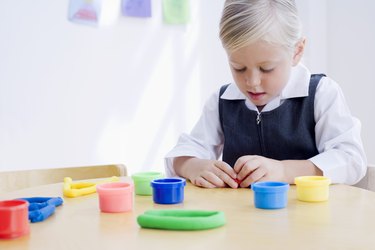Things You'll Need
Paper
Pencil
Colored pencils
22-gauge copper wire
Pliers
Wire cutters
Polymer modeling clay
Cork
Toothpicks
Paper clips
Oven
Paintbrush
Acrylic paints
Clear-coat spray paint

There are quite a few school projects requiring that you create small human figures for various reasons, an architectural rendering for one. Whether you're building a diorama or sculpting the figure to stand alone, the process of creating it remains the same. You can even speed up the process and complete the project in your own home by using polymer clay which can be hardened in a kitchen oven, removing the need for a clay kiln.
Step 1
Create a drawing of how you want your final figure to look. You should draw the figure using multiple viewpoints, at least from the front and from the side. Note the colors you want to apply to your figure in the drawings as well, coloring the drawings themselves using colored pencils to test color combinations.
Video of the Day
Step 2
Choose a scale for your figure, a total height minus the stand that you'd like your figure to stand on. Create an armature, or model, of your sculpture at the desired scale. The armature is a wire stick figure that will serve as both a pose setting and a support skeleton for your figure. Use 22-gauge tarnish-resistant solid copper wire to create the armature. Cut two pieces of the wire, with one twice the length of the other. Bend the long wire in half with a slight loop for the bend and place the second wire in the loop between the bent ends. Hold the loop and loose wire with a pair of pliers at the loop end about a third of the way up from the loop, and twist the two loop wire ends around the loose wire to form the torso for your figure. Cut the loop with a wire cutter to create legs. Bend the remaining wire into the shape of a human, leaving the legs slightly longer than necessary and snipping unneeded wire lengths.
Step 3
Move the human figure into the preferred pose, and then place the leg ends into a piece of cork to hold it stable while you work on the figure.
Step 4
Kneed modeling clay until it is soft and pliable. Place the modeling clay around the posed figure, generally approximating the body of your figure. Body parts should be slightly thicker than your final figure will require, to allow you room to remove material while sculpting the figure.
Step 5
Sculpt the human figure, adding the details from your drawings by removing clay from the figure using modeling tools. You can sculpt the clay using any sharp object that will cut away the clay to your desired detail. Toothpicks and paper clip ends make for good modeling tools at little cost. It's best to work from the skin out, sculpting uncovered parts of the body and then sculpting clothing.
Step 6
Bake the modeling clay according to the manufacturer's directions in order to harden the figure for painting. Allow the model to cool completely.
Step 7
Paint the figure the colors you chose in the drawing stage using acrylic paints. Once painted, you can finish the figure by spraying it with a layer of clear-coat spray to protect the paint job from damage.
Warning
Non-acrylic paints can react badly with the clay, altering the color of the paint and beading on the clay’s surface.
Video of the Day